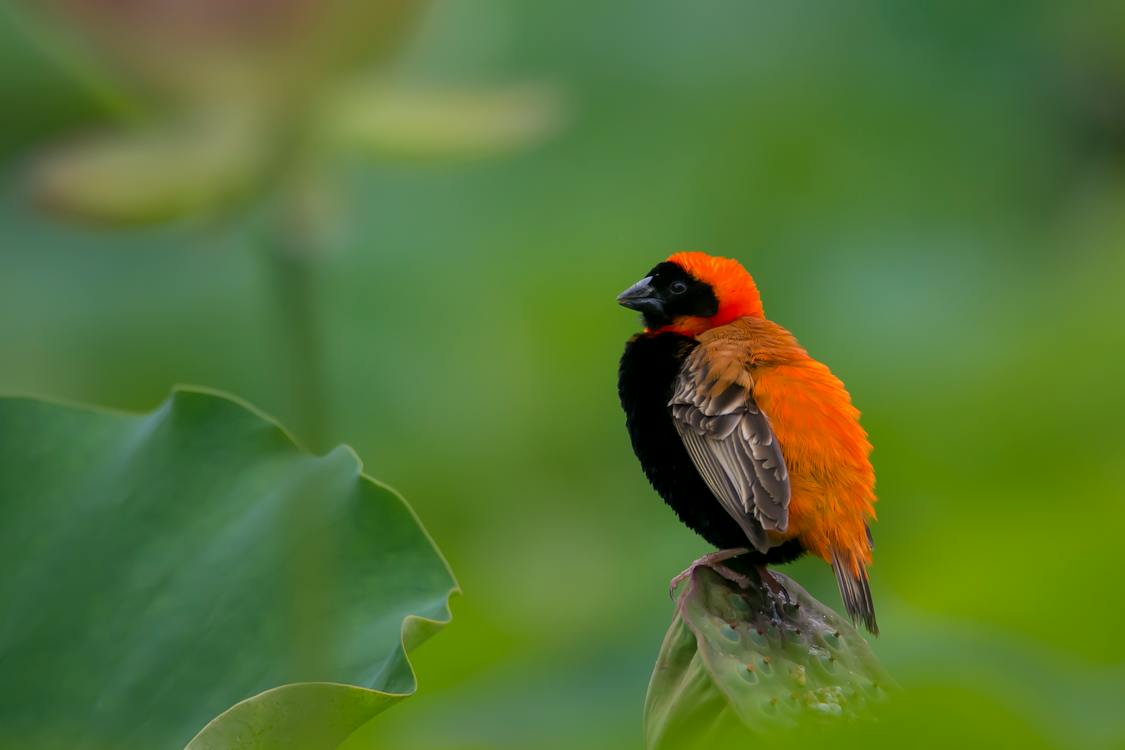BOTSWANA BIRDS | SOUTH AFRICA BIRDS
NAMIBIA BIRDS | ZAMBIA BIRDS | ZIMBABWE BIRDS
The Red Bishop is a tiny bird, about ten to eleven centimeters in size, and a common bird living in the regions of Africa. Formerly, you can regard this bird as the Red Bishop both in North and South Africa. However, over the years, the native Red Bishop was classified into two separate birds called the Northern Red Bishop and the Southern Red Bishop. Both birds have pretty similar appearances since they are sister species, although they do have some distinct features to distinguish their differences.
At first glance, you will have a difficult time identifying the difference between the Northern Red Bishop and the Southern Red Bishop. Both species have almost the same color of plumage, including black and orange – sometimes red. These bright colors only vary its placement on the Northern and Southern Red Bishop.
The Southern Red Bishop has its face, forehead, and bill, color black, and the rest of its head is orange. It has brown wings and tail, and orange or red upper breast and some parts of its back. Its belly going down under the tail is color black.
The Northern Red Bishop is somehow similar to this. However, the Northern Red Bishop has a more vibrant color. Its face and bill are color black, also its forehead – which extends further to the back of the skull. Its whole belly is color black, while the upper wing and tail are brown. It also has pale-colored legs, and there are also color orange plumage surrounding the backside of it.
Habitat
As described earlier, you can spot the Southern Red Bishop in most Southern African countries, mainly in South Africa, Angola, DR of Congo, Zambia, Uganda, Nigeria, and Kenya. Although they are commonly present in South Africa, they are completely absent in the two iconic deserts – the Namib and Kalahari desert. It is because of the Southern Red Bishop mainly resides in grasslands and savanna habitats. During the breeding season, this bird needs to live close to semi-aquatic areas, grass, reeds, and crops such as sugar canes.
The Northern Red Bishop inhabits the northern region of Africa, which includes Liberia, Mauritania, Senegambia, Guinea, Sierra Leone, Eritrea, Ethiopia, Somalia, Burkina Faso, DR Congo, Uganda, Ivory Coast, Chad, Sudan, Cameroon, and Kenya. The habitat of the Northern Red Bishop is more vast compared to the Southern Red Bishop. It covers most of North Africa, as well as some parts of South Africa. Similar to the Southern Red Bishop, it also lives in near-water environments, mainly in tall grasslands and marshes.
Diet and Food Source
Apparent on their habitat, both Red Bishops have a very simple food source, mainly including grass seeds. They also feed on various grasses called Echinochloa, Cortaderia, and Paspalum dilatatum, which are rich in carotenoid, producing pigments that give them the orange or red plumage. Besides grass, they also eat small insects, and they are considerably good at hunting insects, whether on land or while flying. The diet of Red Bishops varies throughout the seasons, depending on what their body needs since the pigments on their plumage is very diet-dependent.
Behavior and Lifestyle
The Red Bishop is a gregarious bird, which is often fond of the company of others, and usually, go out in flocks. Whenever they build nests, they do it in groups, thus, creating nests in colonies, not individually. Although there are no many records about their predators, studies show that these birds build their nest withing reed beds near water to provide coverage from any nearby predators.
During the breeding season, the male birds build several nests for the colony. It is one way to attract female birds. Another way is that it is common for males is they perform a display-flight to attract females using their puffed body plumage. These acts are typical to the Red Bishops since they are usually described as sexually dimorphic – which are also common to some animals, showcasing some unique features in their body.
Another interesting fact about the Red Bishop’s behavior is they are polygynous species. It is common for males is to mate with many females, averaging six females for each male. Its natural trait is the reason why they have the behavior of building nests in colonies.
Population
There is no record for the specific population of the Red Bishop. However, based on the IUCN Red List of Threatened Species, the Red Bishop is on functional status, and it’s widely spread all over the globe. Today, they belong on the list of least concern of endangerment and still manages to be in a stable status.
